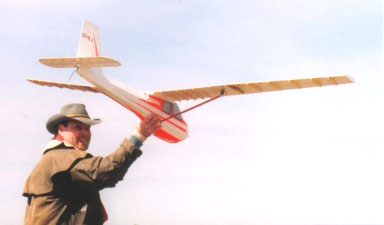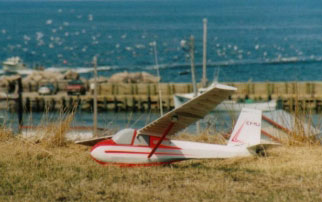
Jacques and his 2-33
by Jacques Des Becquets

Jacques and his 2-33
Type : Scale glider
Wing span : 84 in.
Airfoil : Jedelsky
Surface : 533 sq. in.
Wing loading: 11 on./sq. ft.
Weight : 50on.
Channels : rudder and elevator
Materials : balsa and plywood
Source : scratchbuilt
Comments :
The Schweizer brother (the late Ernest, Bill and Paul A.) are sons of a Swiss immigrants to the United States of America in the early 1900s. All three brothers went on to aeronautical engineering careers and the company bearing their name propelled the U.S. at the forefront of sailplane development on their home continent throughout the 40s, 50s, 60s and 70s.
Their most notable success story, arguably, is the 2-33 series, a two-place training sailplane which was commercialized as of early 1967 as a successor to the straight, wooden-winged 2-22. The 2-22, many felt, was becoming antique in sailplane circles, especially considering the new machines that were being produced, especially in Europe. The new 2-33 sported all-aluminium wings with taper, had more passenger room, was a bit more streamlined thanks to a glass-fiber nose cone and had a rakish tail as opposed to rounded tail feathers, à la 1-26. Its greater wingspan of 51 feet guaranteed better performance. In all, some 579 2-33s were produced until 1982. Today, it still makes up for a lot of the training fleet in North America. The Air Cadet League of Canada owns a good number of them, as do private clubs.
My first exposure to the venerable 2-33 was in the summer of 1985. It was then that I started some sailplane lessons - alas, only 10 before I ran out of time and money - at the Gatineau Gliding Club, located in Pendleton, Eastern Ontario, the home of a former WWII training base. But those rides left a lasting impression on me. The following summer, CF-YLJ became C-FYLJ as it was sold to the Air Cadets. As far as I know, it stills flies in Mountainview, not too far from Kingston, Ontario. Since those days, I've longed to reproduce "Yankee Lima Juliet" in RC format.
I started off with an idea borrowed from the Super Turkey (RC Modeler, February 1978): a Jedelsky (all-balsa) wing. I figured that I would get decent performance out of a wingspan of 84 inches, thanks to about 533 square inches of wing area. I then blew up three-views to the right (or so I hope) fuselage dimensions. The three-views were taken from Martin Simons' excellent book, Sailplanes by Schweizer, co-written by Paul A. Schweizer. Mr. Simons, incidently, is recognized throughout the world as an excellent three-views drawer as well as his previous books on vintage and Slingsby sailplanes. After having blown a transparent copy of the three-views on a wall to the appropriate size, it was a manner of designing my parts and cutting them from regular modeling materials, balsa and a little ply.
The miniature 2-33 emerged. I carefully cut some 1/32 ply for the belly so as to reproduce a semi-monocoque structure. I then covered the belly with some light fiberglass and epoxy, for toughness. Add to this some scrap blue foam, and I thus fashioned the nose cone, canopy and single wheel. Tail feathers were cut out of 1/8 balsa and lightened with some holes. I then covered the model with appropriate (well, close enough) Supercoat covering and I was almost done, except for the two-channel radio installation.

The photos you will see on Louis Cimon's link (merci Louis!) were taken on May 5th, 2002, at the slope in Stonehaven, northern New Brunswick. Conditions were ideal whenever a 20 km/h plus breeze would blow straight in from the north, over the Baie des Chaleurs (Gaspésie across) and over the 40-foot cliff. But that did not always happen. Hence, I only accomplished three or four test flights, not very conclusive at that because of marginal conditions, before I packed my gear to move.
I am now back in the Ottawa area, amidst a group of good modeling friends. Hopefully, I will wrap up some decent test flights on "Yankee Lima Juliet" and see how well - or not - I thought everything over. I would like to thank Daniel Plouffe - he started a 150-inch version of the 2-33 a few years back - for the inspiration, as well as all the modelers who advised me along the way.
My next project? Blow up "YLJ" some more to a wingspan of 150 inches or more and aerotow this new machine with my friends Gudmund, Brian, and MAAC scale sailplane chair Bill Woodward. Okay, when can I hit my building board and let the balsa dust fly?
Jacques Des Becquets
(aeroplane@primus.ca)
02-12-13
![]()